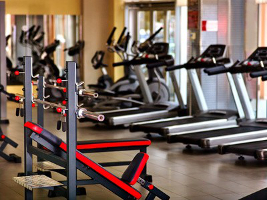Health and Fitness Market Report – Focus on Clubs and Equipment – UK 2016-2020
Available as an Instant Download PDF
This report reviews the market for fitness equipment covering both commercial and individual applications, as well as the UK health club market. The report includes products used in commercial centres (examples of which include gyms and health clubs, local authority leisure centres, hotels, sports clubs and teams and corporate, educational and military facilities), as well as equipment used in the home. Detailed market data and insight on the health and fitness market by Barbour ABI, a leading UK provider of construction market intelligence.
£700.00 Exc. VAT
The 4th edition of the ‘Health and Fitness Market Report – Focus on Clubs and Equipment – UK 2016-2020’ has been published by Barbour ABI. The report covers the health and fitness club sector (private and public), as well as the commercial and home fitness equipment markets.The report contains original input and a detailed assessment of the market and represents excellent value for money to companies in this industry or considering entry.
Key content covered:
- Private Sector Health & Fitness Clubs – Market size and key trends, mix by in-hotel and stand-alone, Mid and Premium sector, assessment by volume of members, number of clubs and revenue.
- Public Sector Health & Fitness Clubs – Market size and key trends, assessment of private leisure management contractors, in-house managed and trust managed facilities, analysis by number of members, sites and revenue.
- Commercial Fitness Equipment – Market size and key trends, main suppliers and brands, specialist suppliers, mix between CV and strength training equipment, imports and exports, and distribution mix.
- Home Fitness Equipment – Market size, trends, analysis of product and distribution mix, key product trends, key suppliers and future prospects.
Key areas of insight include:
- Significant changes within the private health clubs sector – growth of low-cost clubs.
- Developments in the fitness equipment sector – overview of home and commercial equipment sectors – new product trends in 2014-2016.
- Impact of increasing competition and changing technology.
- Growth in niche market segments.
- Market forecasts in 2016 and through to 2020.
- Detailed market data and insight on the health and fitness market by Barbour ABI, a leading UK provider of construction market intelligence.
Some of the companies included:
Bannatyne Fitness, BodyPower Sports, Concept II Ltd, Dave Whelan Sports, David Lloyd Leisure Group, Decathlon, DW Sports Store, énergie Group, Escalade Sports International, Fitness First, Fitness Options, Gymworld, Icon Health & Fitness UK, Johnson Health Tech UK, Jordan Leisure Systems, Kettler (GB), Ladies Workout Express, Life Fitness (UK), New Level UK, Nuffield Health, Powerhouse Fitness, Precor Products, Pulse Fitness, RFE International, Sports Direct, Star Trac Europe, Technogym UK, Topnotch Health & Fitness Clubs, Versaclimber UK, Virgin Active, York Barbell UK.
The Market
- Total market size – analysis by value 2010-2015 with forecasts for 2016-2020, key factors influencing market e.g. increased awareness of health & fitness, industry consolidation and economic climate. Commentary on recent, current and likely future performance.
- Assessment of the market by private and public sector revenue, analysis of the number of facilities in overall terms.
- Key market influences – consumer spending & confidence, increased consumer awareness of health and fitness issues, participation rates in sports, games & physical activities, changing technology, campaigns to encourage sports & fitness etc.
Health & Fitness Club Market
- Health club market size – analysis by value 2010-2015 with forecasts for 2016-2020. Recent growth rates. Analysis of revenue source, joining fees, membership fees, ancillary incomes etc. Comment on recent, current and likely future performance.
- Analysis of 4 key market sectors – private stand-alone health clubs, hotel based health clubs, private and publicly managed local authority facilities – sector shares, trends.
- Market trends & influencing factors – slowdown in development of private fitness facilities; development of niche markets; increasing competition; corporate and local authority sectors; new exercise trends; new product development.
- Assessment of market – development of new club outlets, by membership numbers, and by key market sector – in-hotel and stand-alone development, independent versus chains, together with Premium, Mid-market and Value market analysis. Growth of low-cost gyms – new operations in market, likely future changes.
- Key operators and market shares – changing market structure – leading providers and brands, private sector groups, independents, hotel chains, etc. Company profiles, acquisitions etc.
- Future prospects 2016-2020 and opportunities for the private and public sectors.
Commercial Fitness Equipment Market
- Market Size – analysis by value 2010-2015 with forecasts for 2016-2020. Recent growth levels in the market. Commentary on recent, current and likely future performance.
- Market Trends & Influencing Factors – influence of local authority health and fitness sectors, development of niche markets; new exercise trends; new product development, role of imports etc.
- Impact of Product Innovation & Equipment Upgrading – share mix between strength and CV equipment, market drivers, future changes/trends, changing technology.
- Key suppliers – leading equipment suppliers, share estimates, sector strengths, company profiles etc.
- Future prospects and opportunities for the commercial sector.
Home Fitness Equipment Market
- Market Size – analysis by value 2010-2015 with forecasts for 2016-2020. Market trends & Influencing Factors – new product development, impact of growth of imports etc. Growth/interaction with computer/gaming technologies.
- Product Mix – shares for treadmills, bikes, multi-gyms, free weights etc. key trends in recent years, growth sectors etc.
- Key suppliers and market shares – leading suppliers, share estimates, sector strengths, company profiles etc. Distribution channel analysis – growth sectors/new entrants etc.
- Future prospects and opportunities for the sector.
The health and fitness industry in general has demonstrated a good performance over the past 5 years. The health and fitness club market has experienced a good level of growth since 2011 at 2-3% per annum, with increases in overall total revenue for the sector based on rising levels of membership and in the number of new public and private facilities. The fitness equipment market has seen similar growth of 2-3% per annum. Both markets have benefited from an increased awareness of fitness as an essential component of a healthy lifestyle. This has been achieved through a variety of ways including an increasing focus on sport and fitness in the media and media attention around the rise in obesity levels and campaigns focused around getting young people active.
The UK health and fitness club market continued its steady expansion throughout 2015 with a significant increase in the number of fitness facilities – performance was driven by the low cost sector with the key operators progressing with significant development programmes. As competition in the low cost sector has increased, larger operators have often taken multiple gyms in a town or city to secure their customer base. The higher end of the market incorporating country club and spa facilities has also proven to be resilient. Additional services that many gyms are now providing for their members include specific exercise classes, as well as personalised advice on nutrition and diet.
The UK fitness equipment sector grew by around 3% in 2015, compared with the previous year. Sales of fitness and exercise equipment have risen in line with the improving state of the UK economy, which has led to higher spending by both consumers and operators of commercial gyms (e.g. hotels and local authorities). Recent growth has also been driven by the booming low-cost/budget gym sector, and the corresponding increase in demand for fitness equipment. Within both the home and commercial markets, demand is highly susceptible to new trends and ‘fitness crazes’. Recent examples of trends driving the market include HIIT (High Intensity Interval Training), Zumba classes and use of Vibration Plate equipment. More recently, there have been moves towards equipment that can replicate the feeling and sensation of exercising outdoors, as well as products geared towards training in groups. The UK market for fitness equipment is relatively mature, with many well-established leading suppliers. As a result, the market features a number of well-known brands, although in recent years the growth of lower-cost imports has eroded their position.
The outlook for both of these related markets in the medium term is for modest growth. The health club market is expected to remain in a state of flux as low-cost health clubs continue to gain market share from established medium segment health clubs, leading to lower revenue fees across the industry. The outlook for the commercial fitness equipment market in the short to medium term is for moderate growth of 1-2% per annum. Although the current expansion and investment programmes pursued by many leading health and fitness club operators suggests demand for equipment will rise, a number of towns and cities are saturated in terms of health and fitness establishments and significant growth is unlikely. The future direction of the commercial fitness equipment market is also likely to depend upon how well low-cost and budget gyms continue to develop their presence. At present, this sector accounts for just 5% of the UK’s total number of gyms and health clubs, so there is scope for growth – especially if the economic situation deteriorates as a result of the Brexit vote and consumers reign in their spending on non-essentials. The outlook for the home fitness equipment is also for moderate growth over the next couple of years, although demand may experience a decrease towards the end of the decade.
- Contents Listing
- 1. INTRODUCTION 7
- 1.1 BACKGROUND 7
- 1.2 SOURCES OF INFORMATION 7
- 2. SUMMARY AND FUTURE PROSPECTS 9
- 2.1 SUMMARY 9
- 2.2 MARKET PROSPECTS 10
- 3. ECONOMIC ENVIRONMENT 12
- 3.1 GDP 12
- 3.2 INFLATION & INTEREST RATES 14
- 3.3 UNEMPLOYMENT 15
- 3.4 HOUSEHOLD CONSUMPTION 15
- 3.5 HOUSING & CONSTRUCTION 16
- 3.6 STERLING 17
- 3.7 POPULATION PROFILE 18
- 3.8 CONCLUSIONS 18
- 4. FITNESS EQUIPMENT 20
- 4.1 MARKET DEFINITION 20
- 4.2 MARKET OVERVIEW 20
- 4.2.1 Market Size 20
- 4.3 MARKET MIX 22
- 4.4 KEY MARKET INFLUENCES 23
- 4.4.1 International Trade 23
- 4.4.2 Consumer Spending & Participation Levels 25
- 4.4.3 Funding Streams and Government Campaigns 27
- 4.4.4 Developments in the Commercial Health & Fitness Sector 30
- 4.4.5 Exercise Trends & Product Development 30
- 5. COMMERCIAL FITNESS EQUIPMENT MARKET 33
- 5.1 MARKET DEFINITION 33
- 5.2 MARKET OVERVIEW 33
- 5.2.1 Market Size 33
- 5.2.2 Current Situation 34
- 5.2.3 Market Prospects 35
- 5.3 PRODUCT MIX 36
- 5.4 COMMERCIAL FITNESS EQUIPMENT SUPPLY 38
- 5.4.1 Market Share 38
- 5.4.2 Leading Suppliers 39
- 5.5 DISTRIBUTION 43
- 6. HOME FITNESS EQUIPMENT MARKET 45
- 6.1 MARKET DEFINITION 45
- 6.2 MARKET OVERVIEW 45
- 6.2.1 Market Size 45
- 6.2.2 Market Prospects 47
- 6.3 PRODUCT MIX 48
- 6.4 HOME FITNESS EQUIPMENT SUPPLY 49
- 6.4.1 Market Share 49
- 6.4.2 Leading Suppliers 50
- 6.5 DISTRIBUTION 53
- 6.5.1 Distribution Channel Mix 53
- 6.5.2 Leading Distribution Channels 54
- 7. HEALTH AND FITNESS CLUBS 58
- 7.1 MARKET DEFINITION 58
- 7.2 MARKET STRUCTURE 58
- 7.3 MARKET SIZE & TRENDS 59
- 7.3.1 Overview 59
- 7.3.2 Current Situation 61
- 7.3.3 Market Prospects 62
- 7.4 MARKET MIX 63
- 7.5 THE PRIVATE HEALTH CLUB MARKET 65
- 7.5.1 Market Review 65
- 7.5.2 Market Shares and Company Profiles 68
- 7.5.3 Key Market Segments 73
- 7.6 LOCAL AUTHORITY MARKET 80
- 7.6.1 Market Review 80
- 7.6.2 Market Shares and Company Profiles 81
- Tables & Charts
- CHART 1 FITNESS EQUIPMENT AND HEALTH & FITNESS CLUBS – UK MARKET SIZE AND FORECASTS 2011-2020 (£M) 9
- TABLE 2 GDP DATA – 2013-2016 – KEY CONSTITUENT ELEMENTS 13
- CHART 3 INTEREST RATES AND INFLATION (CPI) FROM 2000-2020 14
- CHART 4 PDI & SAVINGS RATIO AT CURRENT PRICES 2000-2020 16
- TABLE 5 EXCHANGE RATE FLUCTUATIONS 2012-2018 – STERLING TO THE DOLLAR, AND THE EURO, SPOT RATES 17
- TABLE 6 UK FITNESS EQUIPMENT MARKET SIZE AND FORECASTS 2011 TO 2020 (£M AT MSP) 21
- CHART 7 FITNESS EQUIPMENT MARKET MIX 2015 – COMMERCIAL AND HOME FITNESS – % BY VALUE 22
- TABLE 8 GENERAL PHYSICAL EXERCISE, GYMNASTICS & RESISTANCE EQUIPMENT – IMPORTS/EXPORTS – 2010-2015 BY VALUE (£M) 23
- CHART 9 TOP 10 COUNTRIES OF ORIGIN FOR FITNESS EQUIPMENT 2015 (£M) 24
- TABLE 10 CONSUMER SPENDING ON SPORTING & RECREATIONAL SERVICES UK 2005-2015 – BY VALUE (£M) AT CONSTANT PRICES 26
- TABLE 11 UK COMMERCIAL FITNESS EQUIPMENT MARKET SIZE AND FORECASTS 2011 – 2020 (£M AT MSP) 33
- CHART 12 UK COMMERCIAL FITNESS EQUIPMENT MARKET – PRODUCT MIX BY VALUE (%) – CV, STRENGTH/RESISTANCE, ACCESSORIES 2015 37
- CHART 13 LEADING SUPPLIERS OF COMMERCIAL FITNESS EQUIPMENT – % MARKET SHARE BY VALUE 2015 38
- TABLE 14 LEADING SUPPLIERS OF FITNESS EQUIPMENT IN THE UK COMMERCIAL FITNESS EQUIPMENT MARKET 40
- TABLE 15 UK HOME FITNESS EQUIPMENT MARKET SIZE AND FORECASTS 2011 TO 2020 (£M MSP) 46
- CHART 16 PRODUCT MIX IN THE HOME FITNESS EQUIPMENT MARKET – BY VALUE 2015 (%) – TREADMILLS, BIKES, MULTI-GYMS, FREE WEIGHTS, OTHER AEROBIC, ACCESSORIES 48
- TABLE 17 UK HOME FITNESS EQUIPMENT – KEY SUPPLIER MARKET SHARES (% BY VALUE) 2015 49
- TABLE 18 LEADING SUPPLIERS OF FITNESS EQUIPMENT IN THE UK HOME FITNESS EQUIPMENT MARKET 2015 51
- CHART 19 HOME FITNESS EQUIPMENT DISTRIBUTION MIX – % BY VALUE (MAIL ORDER, SPECIALISTS, DEPARTMENT STORES/GROCERY, GENERAL SPORTS ETC) 2015 53
- TABLE 20 UK HEALTH & FITNESS CLUB MARKET SIZE AND FORECASTS 2011 TO 2020 – BY VALUE (£BN) 59
- CHART 21 MARKET MIX BY NUMBER OF CLUBS – PUBLIC/PRIVATE – 2016 (%) 64
- CHART 22 UK HEALTH AND FITNESS MARKET NEW CLUB OPENINGS 2010 TO 2015 – BY NUMBER OF CLUBS 65
- CHART 23 UK PRIVATE HEALTH CLUB MARKET -2010- 2020 (£BN) 66
- CHART 24 HEALTH & FITNESS CLUBS REVENUE SOURCE – 2010 – 2016 (%) 67
- CHART 25 MIX OF PRIVATE SECTOR HEALTH CLUBS – BY TYPE 2016 (%) – INDEPENDENT SINGLE SITES, CHAINS 68
- CHART 26 PRIVATE HEALTH CLUB SECTOR – LEADING OPERATORS MARKET SHARES 2016 (%) 69
- TABLE 27 LEADING PRIVATE HEALTH & FITNESS CLUB BRANDS/ OPERATORS BY NUMBER OF FACILITIES 2016 70
- TABLE 28 LEADING UK BUDGET GYM OPERATORS 2016 – NO. OF CLUBS AND DEVELOPMENT PLANS 75
- TABLE 29 LEADING PRIVATE HEALTH & FITNESS CLUB BRANDS/ OPERATORS 2016 78
- CHART 30 MANAGEMENT OF PUBLIC SECTOR FITNESS CLUBS – IN-HOUSE, LEISURE TRUST, LEISURE MANAGEMENT CONTRACTOR – 2015 (%) 81

Paired Report Discount
Save £250 for every two reports you buy
Discount applied in basket
Frequently bought together
Trusted by industry leaders
For more detailed requests speak to our research experts directly
By using this form you agree that your data will be processed and protected in line with our Privacy Policy.
Research you can depend on
Our reports go deeper to give you the insights needed to make your next strategic move.
- Detailed assessment of the market – analysis of the market structure and recent developments within the market.
- Market prospects up to 4 years – market value, opportunities, impact of Covid-19, Brexit etc.
- Detailed information – market size, influences, market factors and key players.
- Analysis by product group – market size, product mix, sector trends etc.



